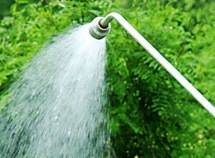Have you ever stood watering the garden on a hot summer afternoon, the sprayer nozzle and hose in one hand and a cool drink in the other?
It feels good, but the trouble is, you’re getting a better drink than your plants are. Why? You’re using the wrong tool for the job.
Watering the garden the right way

Watering throughly once a week is better than a little bit every day
Photo: ©Y.Cunnington
A sprayer nozzle is great for washing the car, but practically useless for gardening watering because it can gush a high-pressure jet that flattens plants.
It’s impossible to stay in one spot long enough to deliver enough water to penetrate the soil to the roots where plants take it up.
Instead, for watering the garden, you’re better off to set up a sprinkler to run for a period of time.
In addition, there’s also the fact that a hot afternoon is about the worst time to water because a lot of the water evaporates in the heat.
Plants need moisture
A healthy plant is 75 to 90 percent water. Adequate water is especially critical during the first few weeks of growth, while plants are building their root systems and getting established.
To water individual plants or plants in containers, rather than a sprayer nozzle, the better tool is a watering can, or hose-end watering wand.
Watering wands have a water breaker with many tiny holes to release water in a soft shower rather than a high-pressure stream.
More tips for watering the garden

A watering wand is a very useful tool.
Don’t water if you don’t have to — too much water is as bad as too little. Measure rainfall and keep track of the amounts on a calendar. Let the soil surface dry between waterings.
The ideal amount: For most gardens the optimal amount of water from rain or watering is an inch every week, but many established plants can easily weather short periods of dryness. If heat and drought are prolonged, water your most valuable plants.
Water thoroughly: Give infrequent but generous waterings, about an inch once a week. Avoid frequent shallow waterings, which only encourage roots to stay near the soil surface. The more deeply rooted your plants, the more resilient they’ll be in a dry period. When you water, do it long enough for moisture to penetrate the top five or six inches of soil. Dig a small hole with your hand trowel an hour after you’ve watered to check.
When to water: The best time for is early in the morning or in the evening. In the heat of the day — between 10 a.m. and 6 p.m. — sun and wind quickly evaporate a significant quantity of water. Overhead watering with a sprinkler is best done in the morning so that leaves can dry off through the day. Foliage that’s frequently wet overnight creates the perfect environment for fungal diseases.
Improve your soil’s moisture-holding capacity: Adding organic matter benefits all soils, but it is especially important for helping sandy soils retain water. (Here’s information on how improve your soil.)
Watering when planting: When planting perennials, trees or shrubs, dig a hole, fill it with water to allow moisture to be absorbed into the soil. Then put the plant into the moistened hole, firm soil around the roots and water again.
Watering while plants are getting established: Keep new plants moist, watering generously once a week if it doesn’t rain adequately. After six to eight weeks, gradually cut back on watering.
Mulch for moisture conservation: Cover bare soil with two to four inches of mulch to help retain moisture. (See Mulch for Your Garden.)
Related Information
Quality garden tools, including tools for watering




